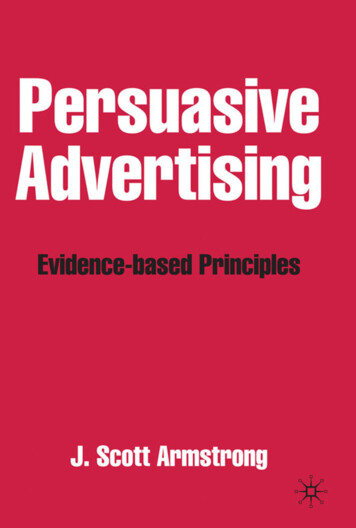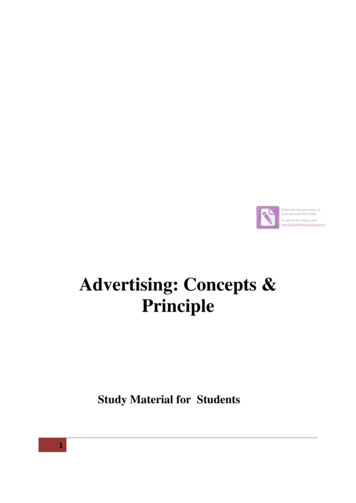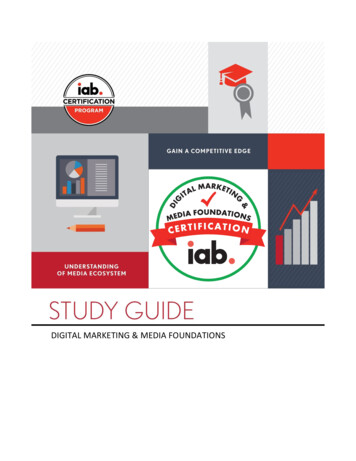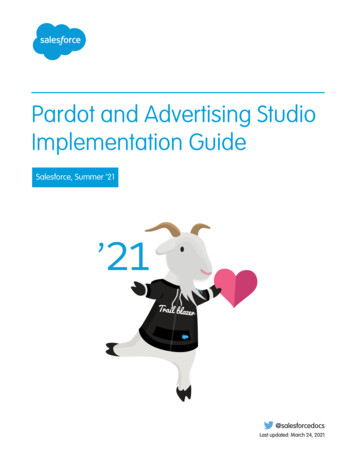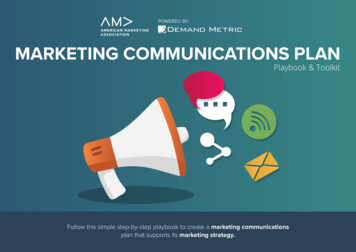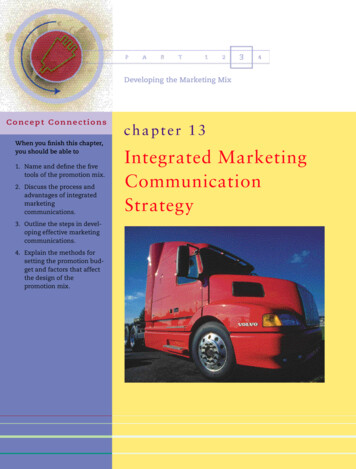
Transcription
Marketing & Advertising Industry NetworkGWebinar: Team Building Skills for MarketersDina Shapiro, CCAS BA '89Chief Executive Officer and Chief LearningOfficer, Yorkville Consulting
Today’s Organizations: Matrixed and Complicated Yorkville Consulting. All rights reserved.
Marketing is a Team Sport Yorkville Consulting. All rights reserved.
Importance of Being a Team PlayerMostorganizationshave aconsensusbuildingcultureStrength innumbers Yorkville Consulting. All rights reserved.Encourageshealthy risktaking
Benefits of Being a Team PlayerFeel connectedArt of influenceStrong relationships and networkCollective wisdom and diversity of thoughtShare best practicesLeverages each person’s strengthsWork through complicated problems togetherAdvance your career Yorkville Consulting. All rights reserved.
Today’s Learning ObjectivesTEAM BUILDING SKILLS FOR ResolutionDialogue vs.DebateShare YourPOV EffectivelyAfter-ActionReviewKeyTakeaways Yorkville Consulting. All rights reserved.
Today’s Learning ObjectivesTEAM BUILDING SKILLS FOR ResolutionDialogue vs.DebateShare YourPOV EffectivelyAfter-ActionReviewKeyTakeaways Yorkville Consulting. All rights reserved.
Most of the Time, We Don’t Choose Our TeamsBALLOT1Yes2Yes3Yes Yorkville Consulting. All rights reserved.
Stages of Group Development1234FormStormNormPerformSource: Tuckman’s Stages of Group Development Yorkville Consulting. All rights reserved.
IntrovertsandExtroverts Yorkville Consulting. All rights reserved.
Introverts and ExtrovertsWhere we get our energy from how we recharge our brains100%Introvertstend to: recharge by spending time alone lose energy from being around people forlong periods of time, particularly largecrowdsSource: Myers BriggsNOTvs.0%Extrovertstend to: recharge by being social gain energy from other people find their energy is drained when theyspend too much time alone Yorkville Consulting. All rights reserved.
What is Your Tendency?These statements generally apply to me:I am seen as"reflective" or"reserved."I feel comfortablebeing alone and likethings I can do on myown.I prefer to know just afew people well.I sometimes spendtoo much timereflecting and don'tmove into actionquickly enough.I sometimes forget tocheck with the outsideworld to see if myideas really fit theexperience.I sometimes jump tooquickly into an activityand don't allowenough time to thinkit over.Before I start aproject, I sometimesforget to stop and getclear on what I wantto do and why.These statements generally apply to me:I am seen as"outgoing" or as a"people person."Source: Myers BriggsI feel comfortable ingroups and likeworking in them.I have a wide range offriends and know lotsof people. Yorkville Consulting. All rights reserved.
Tips to Work with Introverts1234567RESPECTtheir need for privacyLet themOBSERVE in newsituationsFIRSTGive themTHINKtime toAllow them tofinish their thoughtGive them advanceNOTICE of changesProvide feedback 1:1Let them find COLLEAGUESwith similar abilitiesWITHOUTINTERUPTINGSources: Buffer Social Blog; Inc. Extroverts vs. Introverts Yorkville Consulting. All rights reserved.
Tips to Work with Extroverts1234RESPECTtheir independenceCOMPLEMENT THEMin the company of othersACCEPT andENCOURAGEtheirenthusiasmAllow them toEXPLORE and talkthings outSources: Buffer Social Blog; Inc. Extroverts vs. Introverts567Let them DIVE RIGHT INOffer them OPTIONSLet them SHINE Yorkville Consulting. All rights reserved.
Today’s Learning ObjectivesTEAM BUILDING SKILLS FOR ResolutionDialogue vs.DebateShare YourPOV EffectivelyAfter-ActionReviewKeyTakeaways Yorkville Consulting. All rights reserved.
What is Responsibility Charting?Identifies processambiguitiesHighlights differentperspectives Yorkville Consulting. All rights reserved.Resolves these ambiguitiesand differences through across-functional collaborativeeffort
Benefits of Responsibility Charting Yorkville Consulting. All rights reserved.
Engages Across Levels and DisciplinesSource: PMI Yorkville Consulting. All rights reserved.
Accountability Placed With Right PersonNo one person is accountable for everything!Source: PMI Yorkville Consulting. All rights reserved.
Process DisciplinesFocused and systematic dialogueSource: PMI Yorkville Consulting. All rights reserved.
Defines Relationships Across DisciplinesCommunications andactions requiredRoles by discipline(de-personalized)Source: PMI Yorkville Consulting. All rights reserved.
Reconcile Role Conceptions and ExpectationsRoleConceptionRoleExpectationWhat a person thinkstheir job is How someone has been taught to dotheir job Might be influenced misleading titleor adoptions from predecessorWhat others in the organizationthink the person isresponsible forRoleBehaviorWhat a person actually doesin their job May be influenced by incorrectinformation such as from a former jobor inconsistent leadership directionResponsibility Charting reconciles conceptions and expectations,so behavior becomes more predictable and productiveSource: PMI Yorkville Consulting. All rights reserved.
ResponsibilityChartingHow to Kick Start theProcess Yorkville Consulting. All rights reserved.
Responsibility ChartingRACI he Doer”“The Buck Stops Here”“In the Loop”“Keep in the Picture” Subject matter expertconsulted prior to finaldecision Two-waycommunication Informed after decisionor action taken One-waycommunication Who completes thetask Can be shared Ultimately answerablefor activity or decision Yes-no-veto authoritySources: PMI; Wikipedia. Note: RACI is one of multiple approaches. Yorkville Consulting. All rights reserved.
Responsibility ChartingFive Step Process12Identify the work process Established process 10-25 stepsDetermine decisions andactivities Avoid generic, obvious orambiguous steps Begin each step with a goodaction verb534Obtain feedback and buy-in Distribute chart to all on chart whowere not present in development Apply feedbackSource: PMIList each discipline for eachstep Can be individual or group Across disciplines DepersonalizeDevelop RACI chart Start with “R’s”, then “A”, then complete “C’s”and ”I’s” Use facilitator for large or complex projects Yorkville Consulting. All rights reserved.
Today’s Learning ObjectivesTEAM BUILDING SKILLS FOR ResolutionDialogue vs.DebateShare YourPOV EffectivelyAfter-ActionReviewKeyTakeaways Yorkville Consulting. All rights reserved.
Today’s Complex Business MarketCollaboration is Necessary to Compete Easier said than done! Collaboration is NOT the dominant personality saying “do it my way” Good starting points include genuine willingness to:– Work together– Share information– CooperateTrue collaboration is all of that and more requires tough decisions and trade-offsSource: Harvard Business Review Yorkville Consulting. All rights reserved.
Cooperation vs. CollaborationCooperation is Collaboration is EasierHarder, but worth it!Exchange information and resources in support ofeach individual’s goalsCollective team effort to create something new insupport of a shared goalEach individual responsible to solve a portion ofthe problemCoordinated and synchronous group effort toconstruct a shared solutionEach individual controls and makes decisions intheir territoryEach individual gives up some control knowswhen to “fall on a sword” vs. back downUses expertise by siloRequires respect of each subject matter expert,trust and openness to diversity of thoughtWilling to share information,“if you help me, I’ll help you”Align resources with company goals tosynchronize strategies and performance measuresSources: Harvard Business Review, Huffington Post Yorkville Consulting. All rights reserved.
Benefits of Collaboration97%Engages and creates asense of communityamongst team membersSources: Bright Hub; Ingram; elcomMultiple perspectivesto validate ideas andsolve problemsEach individual learnsand retains moreknowledge Yorkville Consulting. All rights reserved.Positively affects theoutcome of a project
Collaboration Best PracticesDon’t rely 100% on emails – communicate live whenever possible Yorkville Consulting. All rights reserved.
Collaboration Best PracticesDon’t rely 100% on emails – communicate live whenever possibleUse responsibility charting Yorkville Consulting. All rights reserved.
Collaboration Best PracticesDon’t rely 100% on emails – communicate live whenever possibleUse responsibility charting? Ask questions to clarify any unclear or inconsistent direction from leadership Yorkville Consulting. All rights reserved.
Collaboration Best PracticesDon’t rely 100% on emails – communicate live whenever possibleUse responsibility charting? Ask questions to clarify any unclear or inconsistent direction from leadershipGet to know your colleagues and their strengths Yorkville Consulting. All rights reserved.
Collaboration Best PracticesDon’t rely 100% on emails – communicate live whenever possibleUse responsibility charting? Ask questions to clarify any unclear or inconsistent direction from leadershipGet to know your colleagues and their strengthsBe confident about your position in the organization and your contributions Yorkville Consulting. All rights reserved.
Collaboration Best PracticesDon’t rely 100% on emails – communicate live whenever possibleUse responsibility charting? Ask questions to clarify any unclear or inconsistent direction from leadershipGet to know your colleagues and their strengthsBe confident about your position in the organization and your contributionsGive everyone on the team equal “floor time” - make sure each meeting has a facilitator Yorkville Consulting. All rights reserved.
Collaboration Best PracticesDon’t rely 100% on emails – communicate live whenever possibleUse responsibility charting? Ask questions to clarify any unclear or inconsistent direction from leadershipGet to know your colleagues and their strengthsBe confident about your position in the organization and your contributionsGive everyone on the team equal “floor time” - make sure each meeting has a facilitatorEmbrace change Yorkville Consulting. All rights reserved.
Collaboration Process FrameworkStepsConsiderations#1Kick-off Map out high level process and responsibility charting Determine timing, and budget if required Obtain executive sponsor#2Convene a working session Include all required collaborators across disciplines Review, revise and commit to collaboration contract#3Set objectives Group level (no one individual discipline can achieve) Make cross-discipline team accountable for performance#4Simplify Review high level process to balance between relevant details andsimplified steps - go for speed, agility & efficiency! Clarify job description and discipline capability definitions#5Behavioral changes Stay laser-focused on collaboration Invest in capabilities to sustain reformSource: Harvard Business Review; McKinsey Yorkville Consulting. All rights reserved.
Today’s Learning ObjectivesTEAM BUILDING SKILLS FOR ResolutionDialogue vs.DebateShare YourPOV EffectivelyAfter-ActionReviewKeyTakeaways Yorkville Consulting. All rights reserved.
Common Reasons for ConflictDifferent goals or ideasSource: HR Council; Chron; LiveStrong Yorkville Consulting. All rights reserved.
Common Reasons for ConflictDifferent goals or ideasNot listeningSource: HR Council; Chron; LiveStrong Yorkville Consulting. All rights reserved.
Common Reasons for ConflictDifferent goals or ideasNot listeningResponding to ideas or questions in an unproductive waySource: HR Council; Chron; LiveStrong Yorkville Consulting. All rights reserved.
Common Reasons for ConflictDifferent goals or ideasNot listeningResponding to ideas or questions in an unproductive wayInadequate informationSource: HR Council; Chron; LiveStrong Yorkville Consulting. All rights reserved.
Common Reasons for ConflictDifferent goals or ideasNot listeningResponding to ideas or questions in an unproductive wayInadequate informationDifferent personality stylesSource: HR Council; Chron; LiveStrong Yorkville Consulting. All rights reserved.
Common Reasons for ConflictDifferent goals or ideasNot listeningResponding to ideas or questions in an unproductive wayInadequate informationDifferent personality stylesFear of changeSource: HR Council; Chron; LiveStrong Yorkville Consulting. All rights reserved.
Common Reasons for ConflictDifferent goals or ideasNot listeningResponding to ideas or questions in an unproductive wayInadequate informationDifferent personality stylesFear of changePower strugglesSource: HR Council; Chron; LiveStrong Yorkville Consulting. All rights reserved.
Common Reasons for ConflictDifferent goals or ideasNot listeningResponding to ideas or questions in an unproductive wayInadequate informationDifferent personality stylesFear of changePower strugglesCompetition for budgets / resourcesSource: HR Council; Chron; LiveStrong Yorkville Consulting. All rights reserved.
Common Reasons for ConflictDifferent goals or ideasNot listeningResponding to ideas or questions in an unproductive wayInadequate informationDifferent personality stylesFear of changePower strugglesCompetition for budgets / resourcesLack of responsibility chartingSource: HR Council; Chron; LiveStrong Yorkville Consulting. All rights reserved.
Common Reasons for ConflictDifferent goals or ideasNot listeningResponding to ideas or questions in an unproductive wayInadequate informationDifferent personality stylesFear of changePower strugglesCompetition for budgets / resourcesLack of responsibility chartingPrevious unresolved conflicts that feed new conflictsSource: HR Council; Chron; LiveStrong Yorkville Consulting. All rights reserved.
Common Reasons for ConflictDifferent goals or ideasNot listeningResponding to ideas or questions in an unproductive wayInadequate informationDifferent personality stylesFear of changePower strugglesCompetition for budgets / resourcesLack of responsibility chartingPrevious unresolved conflicts that feed new conflicts“You’re not doing what I want you to do!”Source: HR Council; Chron; LiveStrong Yorkville Consulting. All rights reserved.
You’re Not Alone!85%Employees experience conflict2.8 hours/week dealing with conflict 359 billion in hours dedicatedto employee conflict75%Source: CPP Global Human Capital ReportConflict morphs intopersonal attackAvoiding conflict results insickness or absence from work Yorkville Consulting. All rights reserved.73%
Destructive vs. Constructive ConflictSource: differencebetween.com Yorkville Consulting. All rights reserved.
Destructive vs. Constructive ConflictDefinitionDESTRUCTIVE CONFLICTCONSTRUCTIVE CONFLICTDisagreement leads to negative outcomes,creating frustration and antagonismDisagreement resolved in a positive mannerthat benefits both partiesSource: differencebetween.com Yorkville Consulting. All rights reserved.
Destructive vs. Constructive ConflictDESTRUCTIVE CONFLICTCONSTRUCTIVE CONFLICTDefinitionDisagreement leads to negative outcomes,creating frustration and antagonismDisagreement resolved in a positive mannerthat benefits both partiesEffect on therelationshipHarms relationshipsStrengthens relationshipsSource: differencebetween.com Yorkville Consulting. All rights reserved.
Destructive vs. Constructive ConflictDESTRUCTIVE CONFLICTCONSTRUCTIVE CONFLICTDefinitionDisagreement leads to negative outcomes,creating frustration and antagonismDisagreement resolved in a positive mannerthat benefits both partiesEffect on therelationshipHarms relationshipsStrengthens relationshipsOutcomeNeither party benefitsWin-win situation, both parties benefitSource: differencebetween.com Yorkville Consulting. All rights reserved.
Destructive vs. Constructive ConflictDESTRUCTIVE CONFLICTCONSTRUCTIVE CONFLICTDefinitionDisagreement leads to negative outcomes,creating frustration and antagonismDisagreement resolved in a positive mannerthat benefits both partiesEffect on therelationshipHarms relationshipsStrengthens relationshipsOutcomeNeither party benefitsWin-win situation, both parties benefitCommunicationNone or unproductiveHonest and openSource: differencebetween.com Yorkville Consulting. All rights reserved.
Destructive vs. Constructive ConflictDESTRUCTIVE CONFLICTCONSTRUCTIVE CONFLICTDefinitionDisagreement leads to negative outcomes,creating frustration and antagonismDisagreement resolved in a positive mannerthat benefits both partiesEffect on therelationshipHarms relationshipsStrengthens relationshipsOutcomeNeither party benefitsWin-win situation, both parties benefitCommunicationNone or unproductiveHonest and openPerformanceReduces performanceImproves performanceSource: differencebetween.com Yorkville Consulting. All rights reserved.
Destructive vs. Constructive ConflictDESTRUCTIVE CONFLICTCONSTRUCTIVE CONFLICTDefinitionDisagreement leads to negative outcomes,creating frustration and antagonismDisagreement resolved in a positive mannerthat benefits both partiesEffect on therelationshipHarms relationshipsStrengthens relationshipsOutcomeNeither party benefitsWin-win situation, both parties benefitCommunicationNone or unproductiveHonest and openPerformanceReduces performanceImproves performanceAction of partiesCannot see that both parties must be involvedBoth parties involved to resolve issueSource: differencebetween.com Yorkville Consulting. All rights reserved.
Some Conflict Resolution StylesACCOMMODATINGCOMPETINGPros: Preserve harmonious relationships, can admit there’s abetter wayCons: Can lead to resentment by unmet needs, can diminishinfluence, martyr stancePros: Decisive, assertive, personal needs metCons: Can damage relationships, shut others downAVOIDINGCOMPROMISEPros: Don’t sweat the small stuff, delays may be usefulCons: Avoidance builds up and then blows, important issuesnot dealt with, can take more energy to avoid than addresshead-onPros: Fixes things quickly, finds temporary settlements tocomplex issuesCons: Can play games, bypasses longer term solutions“It’s okay with me, whatever you want”“My way or the highway”“I will think about it tomorrow”Sources: HR Council; Thomas and Kilman“Let’s make a deal” Yorkville Consulting. All rights reserved.
Recommended Conflict Resolution StyleCOLLABORATE“Multiple heads are better than one”ProsConsFinds the best solution for all, whichleads to: Higher commitment Higher creativity in problem solving Team buildingSources: HR Council; Thomas and Kilman ? Yorkville Consulting. All rights reserved.
How to Resolve Conflict3 Step Process1Recognize there’s a problem thatneeds to be solved23Explore the underlying concernsRequirements Participants must stay collaborative Sit on the same side of the table Never flip into oppositional or hostile stances Check emotions at the doorSources: Harvard Business Review; Psychology Today Yorkville Consulting. All rights reserved.Create a mutually agreeablesolution
Example3 Step ProcessSTEVELORRAINE Yorkville Consulting. All rights reserved.
Step 1Recognize there is a problem to solve“Let’s take a trip someplacenew, far away! I want to traveland explore.”“Not me. That sounds awful. I loveto stay at home. When I have timeoff from work, the last thing I wantto do is travel.” Yorkville Consulting. All rights reserved.
Step 2Explore Underlying Concerns“I was thinking of big trip because Iwant to do active stuff outside. At workI sit at my desk all day. I want to gettake hikes and do fun and invigoratingstuff.”“I understand. But for me, I’d prefer oneplace where we can just chill out. I want torelax, slow down and recuperate.” Yorkville Consulting. All rights reserved.
Step 3Create Mutually Agreeable Solution“So I want to be able to move around a lot,and you want to be able to relax. How about abeach resort? You can chill at the beach. Ican surf and explore. We can stay in that oneplace rather than move around, which youwould prefer.”“Soundsperfect! It’sa deal!” Yorkville Consulting. All rights reserved.
Today’s Learning ObjectivesTEAM BUILDING SKILLS FOR ResolutionDialogue vs.DebateShare YourPOV EffectivelyAfter-ActionReviewKeyTakeaways Yorkville Consulting. All rights reserved.
Definition of DebateSource: dictionary.com Yorkville Consulting. All rights reserved.
Opt for Dialogue Over DebateDebate is Dialogue is Oppositional, with two opposing sides trying toprove each other wrong Listening to understand and find commonground Listening to find flaws, spot differences andcounter arguments Enlarging and possibly changing a participant’spoint-of-view Only one right answer Finding the best solution together Closed-minded Open-minded Seeking closure Seeking new optionsSource: Montgomery School; Diversity Awareness Partnership Yorkville Consulting. All rights reserved.
Today’s Learning ObjectivesTEAM BUILDING SKILLS FOR ResolutionDialogue vs.DebateShare YourPOV EffectivelyAfter-ActionReviewKeyTakeaways Yorkville Consulting. All rights reserved.
Tips to Share Your Point-of-ViewShare yourperspectiveintelligently,concisely andpersuasivelyUse the art ofinfluenceBack up yourpoint of viewwithfacts Yorkville Consulting. All rights reserved.
Practice MindfulnessBe presentBe openListen non-Respect diversityjudgmentallyof thought Yorkville Consulting. All rights reserved.
Yorkville Consulting. All rights reserved.
Today’s Learning ObjectivesTEAM BUILDING SKILLS FOR ResolutionDialogue vs.DebateShare YourPOV EffectivelyAfter-ActionReviewKeyTakeaways Yorkville Consulting. All rights reserved.
After Action ReviewA structured review and debriefing process to analyze:What was expected to happenWhat actually occurredWhat went well and whyWhat can be improved and whySources: Wikipedia; Vanderbilt Yorkville Consulting. All rights reserved.
After Action ReviewBenefitsLearn andoptimizeSources: Wharton; Harvard Business Review; VanderbiltClosure on past,focus on future Yorkville Consulting. All rights reserved.Eliminates“recreating thewheel”
After Action ReviewBest PracticesOpen and honest professional discussionParticipation by everyone on the teamFocus on results of a specific event or projectIdentify ways to sustain what was done wellDevelop recommendations to overcome obstacles Yorkville Consulting. All rights reserved.
After Action ReviewStarter TemplateTeam participants and responsibilitiesProject objectivesProvide a clear summary of concrete andactionable recommendations that willimprove the processIdentify tasks and topics requiringleadership attentionProject summaryWhat went well, why, and how to maintainthis successWhat did not go well, why, what can beimproved and howShare the AAR report with your projectsponsor or other appropriate leaderDe-personalize it all Yorkville Consulting. All rights reserved.
After Action Review (AAR)Tips to Make it a Living Practice1 Schedule AARs consistently to learn from both successes and failures2 Gather relevant facts and figures related to the team’s performance3Make participation mandatory and involve all team members in the discussion,including customers, partners and suppliersFollow the “Rules of Engagement” by sharing joint learning but keeping individual4 comments confidentialSource: Wharton Yorkville Consulting. All rights reserved.
Today’s Learning ObjectivesTEAM BUILDING SKILLS FOR ResolutionDialogue vs.DebateShare YourPOV EffectivelyAfter-ActionReviewKeyTakeaways Yorkville Consulting. All rights reserved.
Key Takeaways: Team Building SkillsTuckman’s stages ofgroup development:bypass “storm” asquickly possibleBe mindful andrespectful of extroverts’and introverts’ differentcommunication stylesand needsImplement responsibilitycharting to clarifyexpectationsMake sure you’recollaborating, not justcooperatingUse constructive, notdestructive conflictOpt for dialogue, notdebateBe open and nonjudgmentalDevelop an after-actionreview template withcross-discipline feedbackand buy-in Yorkville Consulting. All rights reserved.
Learning ReflectionWHAT DID I LEARN TODAY?WHAT WILL I DO DIFFERENTLY? Yorkville Consulting. All rights reserved.
THANK YOU! Contact me to bring this full-day workshop on-site for your illeconsulting.com
Introverts and Extroverts . Source: Myers Briggs . Introverts tend to: recharge by spending time alone lose. energy from being around people for long periods of time, particularly large crowds Extroverts tend to: recharge by being social gain. energy from other people

